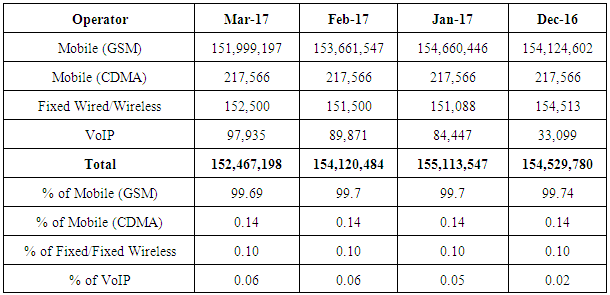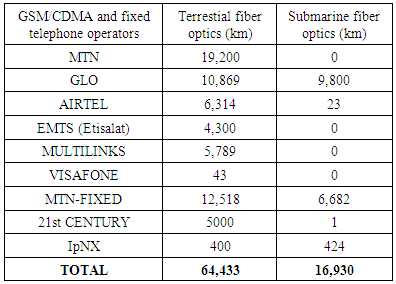-
Paper Information
- Paper Submission
-
Journal Information
- About This Journal
- Editorial Board
- Current Issue
- Archive
- Author Guidelines
- Contact Us
International Journal of Optoelectronic Engineering
p-ISSN: 2167-7301 e-ISSN: 2167-731X
2017; 7(1): 1-12
doi:10.5923/j.ijoe.20170701.01

State of Fiber Optic Networks for Internet Broadband Penetration in Nigeria - A Review
Oboyerulu Edevbie Agboje, Simon Oluwatimilehin Adedoyin, Charles Uzoanya Ndujiuba
Electrical & Information Engineering, Covenant University, Ota, Nigeria
Correspondence to: Oboyerulu Edevbie Agboje, Electrical & Information Engineering, Covenant University, Ota, Nigeria.
| Email: |  |
Copyright © 2017 Scientific & Academic Publishing. All Rights Reserved.
This work is licensed under the Creative Commons Attribution International License (CC BY).
http://creativecommons.org/licenses/by/4.0/

Internet broadband penetration has increased globally as a result of various fiber optic technologies employed. Nigeria fiber optic network is massive and very enterprising because the nation has great potentials in utilizing Internet broadband bandwidths as the largest Black Country in the world. The country presently has active submarine fiber optic cables connecting the country to the world through Europe with huge Internet broadband capacities. However, the Internet broadband penetration in the country is still very low with about 10% of the Oceanic Optical fiber capacities utilized and just 6% of fiber optic broadband penetration. This paper reviews the present state of fiber optics Internet broadband network penetration in Nigeria looking at the spread of fiber optic networks in the country, the application of the fiber optic technologies and the challenges of deploying fiber optic technologies for Internet broadband penetration in Nigeria. The paper classified the fiber optic network in Nigeria into the core, the backbone/backhaul and the access/last-mile fiber optic networks. The core fiber optic network is the oceanic fiber optic from Europe and Cameroun while the backbone fiber optic network is the fiber to the states and to central offices/ISPs. The access/last-mile fiber network is the fiber optic to the base transmission stations and the end users. It can be deduced from this paper that the last mile fiber optic network in the country is still very low and over 99% of the Internet penetration in the country is through the wireless mobile phones.
Keywords: Fiber Optic, Core, Backbone/back-haul, Last-mile, SDH, PON, EP2P, GPON, EPON
Cite this paper: Oboyerulu Edevbie Agboje, Simon Oluwatimilehin Adedoyin, Charles Uzoanya Ndujiuba, State of Fiber Optic Networks for Internet Broadband Penetration in Nigeria - A Review, International Journal of Optoelectronic Engineering, Vol. 7 No. 1, 2017, pp. 1-12. doi: 10.5923/j.ijoe.20170701.01.
Article Outline
1. Introduction
- Internet usage in Nigeria has grown so exponentially that many of the services available for the people are internet based. There is a great potential for Internet bandwidth utilization in the country looking at the population of the country as the most populous Black Country in the world [1]. The country presently has active submarine fiber optic cables connecting the country to the world through Europe deployed by different organizations with huge Internet broadband capacities [2]. However, the Internet broadband penetration in the country is still very low with about 10% of the Oceanic Optical fiber capacities utilized and just 6% of fiber optic broadband penetration [3]. Over 99% of the Internet broadband connection today in Nigeria is through the mobile wireless networks with less than 1% connection via the fixed wired/wireless [4, 5]. Fiber optic networks for Internet broadband deployment in Nigeria can be categorized into three levels. The first level is referred to as the core network, the second level, the backhaul or backbone networks and the third level, the access or last mile networks. The core fiber network connects the country to the world through the submarine fiber optic connection via Europe. The backbone or backhaul networks connect the backbone switches across the states in the country, Internet Service Providers (ISPs) and the central offices. Finally, the access or last-mile networks connect the Base Transmission Stations (BTS), cabinets, organizations, and to the homes [6]. There are five active submarine fiber optic connections that form the core network in Nigeria. Also, there are huge backbone or backhaul networks in the country which allow each state to be connected to some of the submarine fiber optic cables. However, the last-mile network is sparsely covered, resulting in low Internet broadband penetration in the country; about 99% Internet connection is through mobile wireless [3, 6]. According to Ms. Funke Opeke, CEO, Main One Cable Company, “the cost of moving Internet traffic from Lagos to Abuja is four times higher than the cost of moving the same level of traffic from Lagos to London using the fiber optic as a medium” [7]. This shows major challenge in deploying last mile fiber optic network. This paper reviews the present state of fiber optics Internet broadband network penetration in Nigeria by studying the spread of fiber optic networks in the country, the application of the fiber optic technologies and the challenges of deploying fiber optic technologies for Internet broadband penetration in Nigeria. The paper also suggests possible ways of maximizing Internet broadband capacities available in the country by deploying fiber optics to the last miles which is globally referred to as ‘Fiber to the “X”’. The “X” could stand for H-home, C-cabinet, B-building and N-node to form FTTH, FTTC, FTTB, and FTTN respectively [8, 9].
2. Internet Broadband in Nigeria
- The Internet broadband for last mile deployment in Nigeria today is 99% through mobile wireless. Table 1 shows the detailed subscription of data reported by the Nigerian Communication Commission (NCC) [5].
|
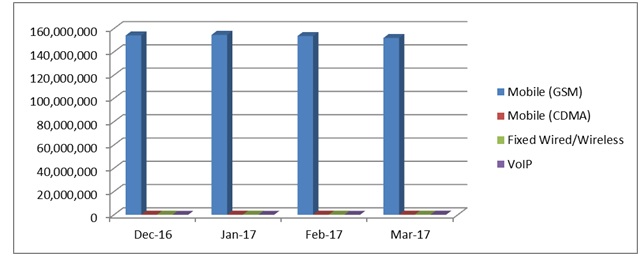 | Figure 1. Internet broadband service subscriptions in Nigeria [5] |
3. Last-mile Technologies in Nigeria
- The last mile technologies deployed in Nigeria for Internet broadband penetration can be classified into two; Wireless and Wired last-mile technologies. The wireless technology is further classified into fixed wireless and mobile wireless. The commonly deployed fixed wireless is the microwave radio which is deployed for organizations that require dedicated and broad bandwidth. The other fixed wireless, though fading out is the very small aperture terminal (VSAT) which is mostly deployed in remote areas. The predominant wireless last mile technology in Nigeria is the mobile wireless. The mobile wireless last-mile technologies commonly employed in Nigeria are Wi-Fi, Global system for mobile communication (GSM), third generation (3G) and fourth generation long term evolution (4G) LTE. The 4G LTE is still sparsely covered especially for those outside the cities like Lagos, Abuja and Port-Harcourt. The other last-mile classification is the wired technology. This is achieved primarily through two media, copper and fiber optic. The technology that uses copper is the Digital subscriber line (DSL). This technology has many styles of deployment that can deliver high Internet broadband especially to homes using the telephone lines. However, the major discouraging factor is vandalism of the copper network in the country. Privatization of the former National carrier, Nigeria telecommunication (Nitel) led to further grounding of DSL technology since they were the potential major player in deploying the technology across the nation. The other medium for the wired technology is the fiber optic. This is the latest wired technology being used to achieve very high Internet broadband penetration globally. The technology for last mile with this wired medium is prominently referred to as Fiber to the “X”. The “X” could stand for H-home, C-curb, B-building and N-node to form FTTH, FTTC, FTTB, and FTTN respectively [18].
4. Fiber Optics Spread in Nigeria for Internet Broadband Penetration
- There is a wide spread of fiber optic deployment in Nigeria for the core and backbone networks to provide Internet broadband connectivity. Nigeria currently has five Submarine fiber optics cable networks connecting the country to the world with Internet broadband capacity of over 27Tbps. However, Internet broadband penetration at subscriber’s levels is still very low and majority of the fiber optic networks in the country are concentrated in the urban areas. More so, the private telecommunications companies deploying mobile services are the ones with the highest numbers of fiber optic deployment in the country. These companies focus more on deploying fiber optics to solve their immediate networks challenges. They also deploy fiber optic to where they will be able to earn back their investment in a very short time. Thus, majority of inter-state fiber optics deployed in Nigeria by these mobile companies are to form backbone for their switches. Furthermore, the fiber optic network by the former National Carrier, Nigerian telecommunication (Nitel) is extinct [6]. The fiber optic networks for Internet broadband penetration in Nigeria is classified into three (3) in this paper. These are the core fiber optic network, the backbone or backhaul fiber optic network and the access or last-mile fiber optic networks.
4.1. The Core Fiber Optic Network in Nigeria
- Nigeria has a total of six active international submarine fiber optic cable networks that formed the core networks. Five of them are connected to the world via Europe while one is connected to a neighbouring country, Cameroun. The landing points of all these are in Lagos State. The submarine cable to Cameroun is called Nigeria Cameroun Submarine Cable (NCSCS) with cable length of 1,100km. It's owned by Cameroun Telecom (Camtel) and its landing points are Kribi, Cameroun and Lagos, Nigeria.The submarine fiber optic cables connecting the country to the world through Europe have capacity exceeding 27Tbps. The detail of the deployment is highlighted below [2];1. SAT-3/WACS, deployed in April, 2002. The cable length is 14,350km. It is jointly owned by Nigeria (NATCOM) and other Countries/Companies [2].2. MainOne, deployed in July 2010. The cable length is 7,000km. It is owned by MainOne Cable Company.3. Glo 1, deployed in October 2010 with cable length of 9,800km. It is owned by Globacom Limited.4. West Africa Cable System (WACS), deployed in May 2012 with cable length of 14,530km. It is jointly owned by MTN Group and others and was upgraded in 2015 [10].5. African Coast to Europe (ACE), deployed in December 2013 with cable length of 17,000km. It is jointly owned by Dolphin Telecoms and others. Table 2 summarizes the submarine cables deployed to Nigeria. Figure 2 shows the submarine fiber optic connection to Africa. The fiber optic technology used for the core network is the Dense Wavelength Division Multiplexing (DWDM) [6].
|
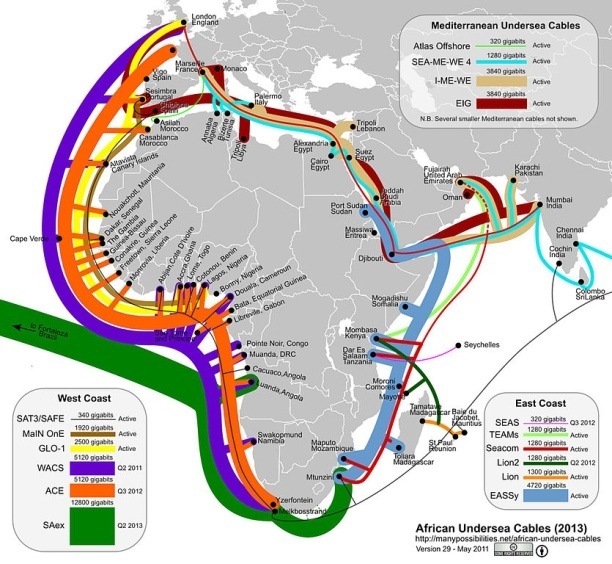 | Figure 2. Submarine fiber optic networks in Africa [2] |
4.2. Backbone Fiber Optic Networks in Nigeria
- Nigeria has primary fiber optic backbone infrastructure presence in all the 36 state capitals and the Federal Capital Territory (FCT), with most fiber infrastructure concentrated in state capitals and a few urban centers. Of the 774 existing local government headquarters very few are connected on the route of the primary fiber backbone. Metropolitan networks only cover part of Lagos, Port Harcourt and Abuja [6]. The National wholesale fiber optic networks that are operational are all owned by private investors in the countries. Some of these investors are, Globacom Limited, MTN Group, Multilinks, Etisalat, Phase 3/Dancom, Airtel and Main One [7, 14, 32]. The optical fiber network of former National Carrier, Nigerian Telecommunication (NITEL) is not active. NITEL deployed large number of fiber optics across the nation, but presently not operational. Nigerian Communications Commission (NCC) 2014 year-end Report captures 80,938km length of fiber optics deployed by Mobile GSM/CDMA and Fixed operators as at December, 2014 [4, 12]. The backhaul/backbone fiber optic networks are deployed by the telecommunication companies to enhance their network performance. Thus, the backhaul/backbone fiber optic connections are to their core switches and to service base transmission stations not for open access to enhance last mile fiber optic connection. The NCC, through the Universal Service Provision Fund (USPF) started a project called Backbone Transmission Infrastructure Network (BTRAIN) which was aimed at facilitating the connection of the rural and semi urban areas to the core fiber optic network. So far, BTRAIN project has delivered 283km backbone fiber optic network to some villages in the Northern part of the country [13]. Figure 3 shows GLO 1 fiber optic backbone network in Nigeria. Phase 3 Telecoms has 7000km open access aerial fiber optic largely via the Power Holdings Company of Nigeria (PHCN) transmission lines across the Country. The company provides fiber optic connectivity, networks management and data storage services to wholesale, enterprise and retail customers across West Africa. [14]. The DWDM is used to deploy the fiber optic network across the state in order to maximize the fiber optic links.
 | Figure 3. Oceanic Fiber Optic Connections to Nigeria [2] |
4.3. Last-mile Fiber Optic Networks in Nigeria
- The fiber optic last mile network deployment in Nigeria is very low with connections mainly to multinational organizations, Base Transmission Stations (BTS), big enterprise network organizations and a few Universities. Also, there are some telecommunications companies already deploying Gigabit capable Passive Optical Network (GPON) last mile technology to some customers in secured estates in cities like Lagos and Abuja. Figure 5 shows the three levels of fiber optic network in Nigeria. The challenges of fiber optic last mile network are briefly discussed in section V. From table 3 and figure 3, the backhaul/backbone and last-mile fiber optic networks on land are 64,433km while the submarine is 16,930km [4]. The majority of the fiber optic network from this report is backhaul/backbone network. The Nigerian telecommunication companies captured in this report are MTN Nigeria, Glo, Airtel, Etisalat, Multilinks, Visafone, 21st Century Technologies and IpNX. MTN Nigeria has the mobile network and the fixed networks. There are Phase 3 Telecoms deploying aerial fiber optic through the PHCH transmission lines for both backbone and last-mile fiber optic networks. Some use the fiber optic networks as point to point links for their customers, while others use it as media to carry last-mile Internet broadband [14].
|
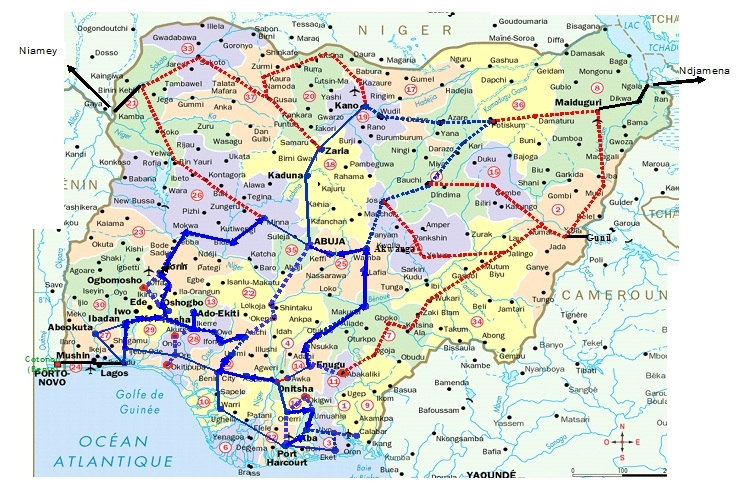 | Figure 4. Glo fiber optic backbone networks [6] |
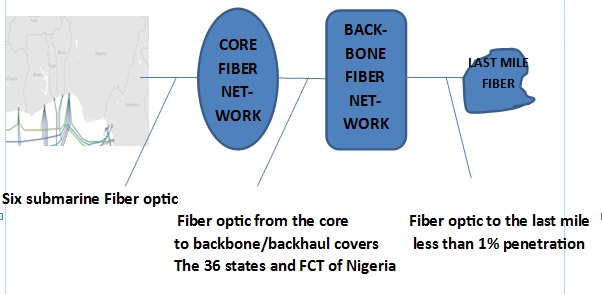 | Figure 5. Three levels of fiber optic spread in Nigeria |
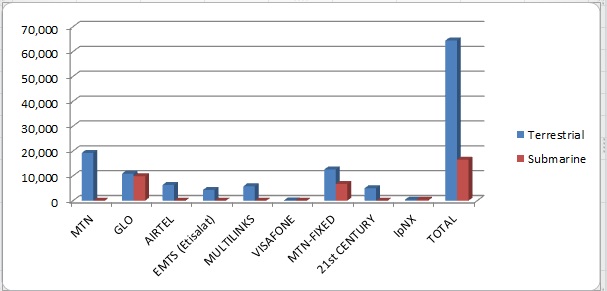 | Figure 6. Fiber optics deployed by mobile and fixed operators [3] |
4.3.1. Synchronous Digital Hierarchy (SDH)
- The SDH is a multiplexing scheme design for optical networks used mainly for optical transportation for backbone/backhaul networks [27]. It is also used as last mile networks for customers that demand high dedicated internet bandwidths. SDH, as a transport hierarchy is based on multiples of 155.52Mbps for STM-1. Thus we have STM-4; 4*155.52 = 622.08Mbps, STM-16, 16*155.52= 2588.32Mbps, STM-64, 64*155.52= 9953.28 and so on [30]. It is a P2P last mile technology and could be active or passive depending on how close the central office (CO) is to the subscribers. Some ISPs in Nigeria such as 21st Century and MainOne are deploying this technology to organizations (Universities, multinational companies etc.) with enterprise network.
4.3.2. Ethernet Point to Point (EP2P)
- Ethernet in the First Mile Alliance (EFMA) group was formed to integrate fiber optics into the Ethernet solution for optical access network due to widespread adoption of the Ethernet protocol in the local networks and the fast access networks [19]. Ethernet P2P can be Active optical Network (AON) or Passive optical Network (PON). The Active Optical Network Ethernet P2P requires active components in between the Central Office and the last mile, while the Passive Optical Network P2P does not require any active components in between the Central Office and the subscribers’ places. Ethernet point to point offers enough bandwidth for large organizations and it may also be considered for small businesses that requires high bandwidth. However, it’s not economical for residential customer. It offers dedicated bandwidth to the last mile. It supports transmission speed of 100mbps for a slower link (100BASE-X) or 1000mbps for a faster links (1000BASE-X) [19]. It can cover distance above 10km which is much better compared to different DSL architectures. Figure 7 shows a typical Ethernet point to point network.
4.3.3. Passive Optical Networks (PON)
- The basic operation of this PON system is to deliver Internet broadband from the central office (CO) with the optical line terminal device through the optical distribution network (ODN) with the splitter to the subscribers where the ONUs are located. Figure 8 shows the block diagram.Passive optical networks are fiber optic last mile technologies that are used in deploying FTTX architectures. They do not require any active element in between the Central office (CO) and the subscribers’ premises. Most PONs are point-to- multipoints except for the Ethernet point-to-point PON, and it is termed passive because no active component exists between the central office and the customer’s premises.
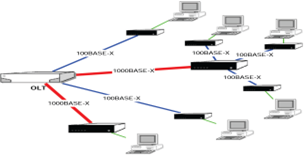 | Figure 7. Ethernet point to point last mile networks [19] |
 | Figure 8. Block diagram of PON |
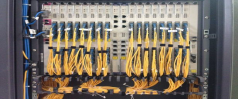 | Figure 9. Picture of OLT [21] |
 | Figure 10. Optical splitter [21] |
 | Figure 11. Optical network Unit (ONU) [21] |
|
5. Challenges of Fiber Optic Deployment in Nigeria
- Nigeria has great potential for Information and Communication Technology (ICT) growth and utilization. Fiber optic technology globally is a great technology that enables the technological advancement of any nation. However, fiber optic deployment in Nigeria has the following challenges (i) Right of Way (ROW) issues: Administrative procedures involved in Right of Way (ROW) procurement are cumbersome and expensive. Most times this results to multiple taxation from the Federal, State and Local Government [6, 16].(ii) Unplanned Towns and Cities: When roads are being constructed, telecommunication facilities and other facilities are not put into consideration. The existing infrastructures are often destroyed due to poor documentation, and new ones may not be installed after the road has been completed [6, 12].(iii) Poor Infrastructure Sharing: Every ISP or Telecommunication Company wants to put their own infrastructure in place. For example, there are over four different companies that laid fiber optic from Lagos to Abuja following almost the same route [28]. They could not share due unfavorable government policies. The government gave individual license for the right of way.(iv) Security Challenges and Vandalism: Sabotage and vandalism tend to discourage fiber optic expansion in the country, although vandalism is less in fiber optic than metallic cables.(v) Low Government Participation: Government involvement in putting fiber optic infrastructure has been very low generally in all the states of the country. Figure 12 shows the threats new projects have on existing fiber optic infrastructure which is due to lack of planning and proper documentation. Picture 1 shows water project exposing fiber optic infrastructure.Pictures 2 and 3 show fiber optic sleeves (joint enclosures) hanging on the roof and one kept on the floor to keep the link up. Picture 4 shows fiber optic laid on electrical pole temporary due to ongoing road construction works. The pictures were taken at Bariga Local Council Development Area (LCDA), Lagos, Nigeria.
 | Figure 12. Fiber optic cables threat in Nigeria (Picture taken at Bariga LCDA, Lagos, Nigeria on March 6, 2017) |
6. Benefits of Fiber Optic Networks in Nigeria
- Prior to 1999, Telecommunication services were expensive to acquire. Teledensity stood at 0.04% (about 400,000 users) in a country with an estimated population of over 100 million people which was one of the lowest in the world. As at today, the teledensity is 99.7% with over 130 million active lines [4]. The influx of fiber optic networks plays a vital role in achieving this. As at year 2002, there was only one International submarine connection but now there are five International submarine fiber optic connections to Nigeria. Also, there are inter-state fiber optic networks in every state which has enhanced quality of service of both voice and data solutions. Five cogent benefits of fiber optic networks in Nigeria are highlighted below;I. Internet data price has fallen from $6000 US dollars per mbps in 2004 to $100 US dollars in 2012 depending on the volume purchased [12].II. Internet data subscription has increased from 27,967,723 in September 2012 to 92,975,682 in September 2017 [4].III. Fiber optic networks have enhanced quality of service for both voice and data solutions. Many core base stations in Nigeria are connected with fiber optic hereby reducing down time and radio point to point challenge [33].IV. There is wider coverage of telecommunication networks as a result of the advent of fiber optic networks. The presence of fiber optic network in every state has enhanced wider coverage [6].V. Fiber optic networks have increased voice subscription from less than 20,000,000 in 2004 to over 100,000,000 in 2014 [4]. Figure 13 shows this remarkable increment.
 | Figure 13. Active voice subscription (1999-2014) |
7. Nigeria Fiber Optic Internet Broadband Plan
- The previous administration began a planned project on National fiber optic network, and developed an open access model for the Next Generation Optic Fiber Broadband Network in Nigeria. Though this project, the government was able to set up Infrastructure Companies (Infracos) in each of the six (6) regions in the country. A separate Infraco was designed solely for Lagos state due to its market size. Therefore, a total of seven (7) Infracos were established altogether. The open access model for optical networks across the country will make operators, whether large or small to have equal access to fiber optic broadband networks at regulated prices. Furthermore, the model will help deliver fast and reliable Internet broadband services to households and businesses by addressing various challenges of last mile fiber optic mostly associated with common constraints such as congested and unplanned towns, infrastructure sharing and high cost of Right of Way (RoW) [31]. However, none of the two licensed Infracos; MainOne Cable Company for Lagos state and IHS for North Central, has begun any meaningful fiber optic networks infrastructure due to several bottle necks. In Lagos, other ISPs are still deploying fiber optics networks for their core switches, and road construction project is affecting the deployment. The other five (5) Infracos ought to have been given license in July 2017 according to Nigerian Communications Commission (NCC). The seven areas are Lagos, South-west, South-East, South-South, North-West, North-Central and North-East. These Infracos are to deliver non-discriminatory open access fiber optic metropolitan networks for the region assigned to them so that retail ISPs can take from a point of access to the last mile, that is the customer’s place [29]. Finally, the Federal government has approved the extension of landing points of submarine fiber optic networks that form the core to other coastal areas of the country other than from Lagos. [28]. The Federal government is also working hard to incorporate the State Governments in achieving Internet broadband penetration in the country [28].
8. Urgent Need for Fiber Optic Internet Broadband Penetration in Nigeria
- Globally, internet broadband accessibility is the major driving force of development. World Bank has validated that a 10% increase in broadband penetration in developing countries guarantees a corresponding increase in GDP by 1.3% [3]. Nigeria has huge internet broadband capacity at her shores through the submarine fiber optic cable to Europe which is not being maximized presently. Hence, there is an urgent need to deploy last mile technologies that will maximize the available internet broadband capacity. Fiber optic last mile technology is the best choice of internet broadband penetration in Nigeria because of the following reasons;Ÿ It has very high capacity, light weight, small size and immunity to electromagnetic interference and cross talk.Ÿ Emerging wide bandwidth can take applications like two-way video conferencing, video-on-demand (VOD), high definition television and interactive gaming needs an uninterrupted high internet bandwidth powered by a communication medium like fiber optic to be able to enjoy the these applications.Ÿ Very fast and reliable internet usage can only be realized by a very high speed connection using a medium like fiber optic.Ÿ Fixed wired last mile technology deployment gives a more reliable and fast internet connection globally. The copper deployment as fixed wired technology is fading away in Nigeria hence the only available fixed cable last mile technology is fiber optic.Ÿ Internet of Things (IoT), emerging technology globally can only be fully realized with a strong internet broadband accessibility which fiber optic last mile technology offers.Ÿ Nigeria is already campaigning for moving the television transmission to full digital. With FTTH architecture using any of the PON technologies, digital television can easily be realized because fiber optic technology offers triple play solutions. That is, the voice (VoIP), the data and the video (IPTV). Ÿ Presently, over 99% of the internet broadband penetration in Nigeria is through the wireless mobile. Congestion is experienced in accessing internet broadband in densely populated areas during the peak period with wireless mobile. With fiber optic last mile deployment, over reliant on mobile wireless will be drastically reduced hereby causing a more effective deployment of mobile wireless and maximization of the huge bandwidth the country has.Ÿ In the long run, fiber optic last mile deployment is cost efficient and effective.
9. Conclusions and Recommendations
- Fiber optic networks across the nation are still inadequate, looking at the population of the country and the Nigeria vision 20:2020 economic transformation blueprint. The fiber optic last mile deployment for Internet broadband penetration in the country is still very low, though there are fiber optic networks in every state of the country. The greatest challenge of fiber optic last mile deployment is lack of open access fiber optic duct management system, which is among the challenges enumerated in section V of this paper. The NCC needs to work with the state governments to successfully deliver the National fiber optic broadband project to be executed by the Infracos at various regions in order to have an open access duct management system for fiber optic last mile deployment. The State Governments are still issuing ROW to individual Telecoms Companies to lay their fiber optic networks in their states thereby affecting full operation of the Infracos. There is a need for the Infraco to partner with the State government and Local Government in Private Public Partnership Scheme so that the Fiber optic network Infrastructure can be jointly owned. This will reduce ROW charges and insecurity of the Infrastructure. Also, the State government and Local Government will ensure that no more ROW permit to any other company except for the licensed Infracos. More so, the NCC must be ready to compensate those companies that have already deployed long distance backhaul Fiber optic Networks Infrastructure or acquire the Infrastructure for an open access broadband access.Furthermore, the NCC should work on getting the Fiber optic networks map for inter-state connectivity using the Geographical Information System (GIS) of all Telecoms Companies that have. The Government through the NCC should ensure that Infraco responsible for a particular region is fully involved in any road construction project in order to incorporate fiber optic networks infrastructure in the project. Fiber optic technology for last mile internet penetration is a global approach to enhance internet broadband maximization. The core and backbone/backhaul networks already have huge deployment in Nigeria which can still be improved upon by extending the landing points of the submarine cables connecting the nation to the world through Europe to other coastal regions of the country. Also, direct submarine fiber optics can be connected to South America to further increase the core network bandwidth through the submarine. Lastly, the fiber optic last mile technology is surest way to maximize the internet broadband huge capacity the country has.
 Abstract
Abstract Reference
Reference Full-Text PDF
Full-Text PDF Full-text HTML
Full-text HTML